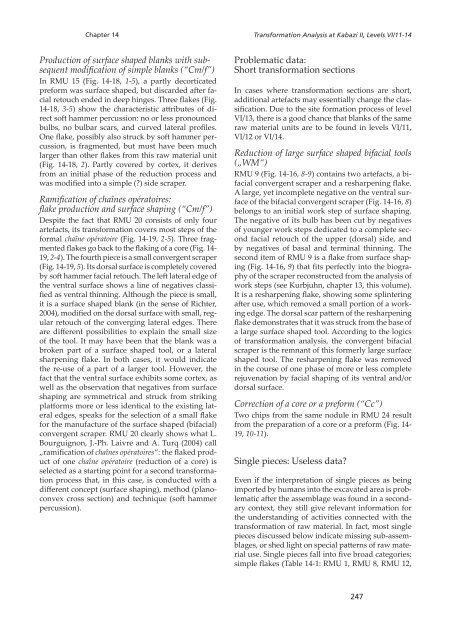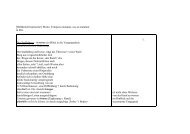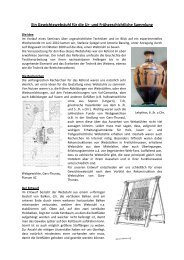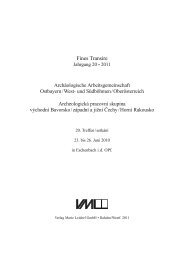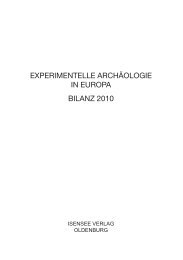Thorsten Uthmeier & Jürgen Richter
Thorsten Uthmeier & Jürgen Richter
Thorsten Uthmeier & Jürgen Richter
Create successful ePaper yourself
Turn your PDF publications into a flip-book with our unique Google optimized e-Paper software.
Chapter 14<br />
Production of surface shaped blanks with subsequent<br />
modification of simple blanks (“Cm/f”)<br />
In RMU 15 (Fig. 14-18, 1-5), a partly decorticated<br />
preform was surface shaped, but discarded a�er facial<br />
retouch ended in deep hinges. Three flakes (Fig.<br />
14-18, 3-5) show the characteristic a�ributes of direct<br />
so� hammer percussion: no or less pronounced<br />
bulbs, no bulbar scars, and curved lateral profiles.<br />
One flake, possibly also struck by so� hammer percussion,<br />
is fragmented, but must have been much<br />
larger than other flakes from this raw material unit<br />
(Fig. 14-18, 2). Partly covered by cortex, it derives<br />
from an initial phase of the reduction process and<br />
was modified into a simple (?) side scraper.<br />
Ramification of chaînes opératoires:<br />
flake production and surface shaping (“Cm/f”)<br />
Despite the fact that RMU 20 consists of only four<br />
artefacts, its transformation covers most steps of the<br />
formal chaîne opératoire (Fig. 14-19, 2-5). Three fragmented<br />
flakes go back to the flaking of a core (Fig. 14-<br />
19, 2-4). The fourth piece is a small convergent scraper<br />
(Fig. 14-19, 5). Its dorsal surface is completely covered<br />
by so� hammer facial retouch. The le� lateral edge of<br />
the ventral surface shows a line of negatives classified<br />
as ventral thinning. Although the piece is small,<br />
it is a surface shaped blank (in the sense of <strong>Richter</strong>,<br />
2004), modified on the dorsal surface with small, regular<br />
retouch of the converging lateral edges. There<br />
are different possibilities to explain the small size<br />
of the tool. It may have been that the blank was a<br />
broken part of a surface shaped tool, or a lateral<br />
sharpening flake. In both cases, it would indicate<br />
the re-use of a part of a larger tool. However, the<br />
fact that the ventral surface exhibits some cortex, as<br />
well as the observation that negatives from surface<br />
shaping are symmetrical and struck from striking<br />
platforms more or less identical to the existing lateral<br />
edges, speaks for the selection of a small flake<br />
for the manufacture of the surface shaped (bifacial)<br />
convergent scraper. RMU 20 clearly shows what L.<br />
Bourguignon, J.-Ph. Laivre and A. Turq (2004) call<br />
„ramification of chaînes opératoires“: the flaked product<br />
of one chaîne opératoire (reduction of a core) is<br />
selected as a starting point for a second transformation<br />
process that, in this case, is conducted with a<br />
different concept (surface shaping), method (planoconvex<br />
cross section) and technique (so� hammer<br />
percussion).<br />
Transformation Analysis at Kabazi II, Levels VI/11-14<br />
Problematic data:<br />
Short transformation sections<br />
In cases where transformation sections are short,<br />
additional artefacts may essentially change the classification.<br />
Due to the site formation process of level<br />
VI/13, there is a good chance that blanks of the same<br />
raw material units are to be found in levels VI/11,<br />
VI/12 or VI/14.<br />
Reduction of large surface shaped bifacial tools<br />
(„WM“)<br />
RMU 9 (Fig. 14-16, 8-9) contains two artefacts, a bifacial<br />
convergent scraper and a resharpening flake.<br />
A large, yet incomplete negative on the ventral surface<br />
of the bifacial convergent scraper (Fig. 14-16, 8)<br />
belongs to an initial work step of surface shaping.<br />
The negative of its bulb has been cut by negatives<br />
of younger work steps dedicated to a complete second<br />
facial retouch of the upper (dorsal) side, and<br />
by negatives of basal and terminal thinning. The<br />
second item of RMU 9 is a flake from surface shaping<br />
(Fig. 14-16, 9) that fits perfectly into the biography<br />
of the scraper reconstructed from the analysis of<br />
work steps (see Kurbjuhn, chapter 13, this volume).<br />
It is a resharpening flake, showing some splintering<br />
a�er use, which removed a small portion of a working<br />
edge. The dorsal scar pa�ern of the resharpening<br />
flake demonstrates that it was struck from the base of<br />
a large surface shaped tool. According to the logics<br />
of transformation analysis, the convergent bifacial<br />
scraper is the remnant of this formerly large surface<br />
shaped tool. The resharpening flake was removed<br />
in the course of one phase of more or less complete<br />
rejuvenation by facial shaping of its ventral and/or<br />
dorsal surface.<br />
Correction of a core or a preform (“Cc”)<br />
Two chips from the same nodule in RMU 24 result<br />
from the preparation of a core or a preform (Fig. 14-<br />
19, 10-11).<br />
Single pieces: Useless data?<br />
Even if the interpretation of single pieces as being<br />
imported by humans into the excavated area is problematic<br />
a�er the assemblage was found in a secondary<br />
context, they still give relevant information for<br />
the understanding of activities connected with the<br />
transformation of raw material. In fact, most single<br />
pieces discussed below indicate missing sub-assemblages,<br />
or shed light on special pa�erns of raw material<br />
use. Single pieces fall into five broad categories:<br />
simple flakes (Table 14-1: RMU 1, RMU 8, RMU 12,<br />
247


